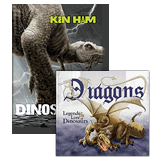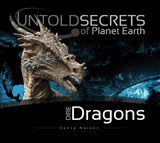
Chapter 28
How Can We Use Dinosaurs to Spread the Creation Gospel Message?
When children, young people, and adults are informed about the truth of dinosaurs, they can answer the questions of a skeptical world and spread the good news of the gospel.
Dinosaurs are some of the most fascinating animals, and children especially are intrigued by them. This is one reason why evolutionists use them, over and over, to teach millions of years and evolution. Christians, however, should use dinosaurs to teach the true history of the universe. When children, young people, and adults are informed about the truth of dinosaurs, they can answer the questions of a skeptical world and spread the good news of the gospel. When dinosaurs are used to spread the gospel, they become “missionary lizards.”
Evidence of Creation
According to evolutionary teaching, dinosaurs roamed the earth millions of years ago and evolved from other types of animals. But what does the Bible say about the origin and history of dinosaurs? From Genesis 1:24–31, we can glean that dinosaurs were created on Day 6, the same day that God made the other land-dwelling, air-breathing animals, along with the first man and woman. Dinosaurs did not evolve from other animals, nor did any other animal evolve from dinosaurs. God created the original kinds of dinosaurs, and they multiplied from there, reproducing according to their kind.
As scientists have studied the fossils of dinosaurs, they have found that dinosaurs can be divided into two main groups: saurischian (“lizard-hipped”) and ornithischian (“bird-hipped”). In saurischian dinosaurs, the ischium and pubis bones are forked beneath the ilium. This group of dinosaurs includes the large sauropods, such as Apatosaurus and Diplodocus. In ornithischian dinosaurs, the pubis and ischium lie side by side underneath the ilium. Ornithischian dinosaurs include Stegosaurus, Triceratops, and Hadrosaurus—the “duck-billed” dinosaur.
These two groups of dinosaurs are still dinosaurs, however, even though they vary in many ways. God created the various dinosaur kinds with great variety. This variety is seen in some of the most popular dinosaurs.
Popular Dinosaurs
Scientists have classified over 300 dinosaur species, but it is reasonable to assume that different sizes, varieties, and sexes of the same kind of dinosaur have ended up with different names. There may have been only 50 or fewer original kinds of dinosaurs that God created on Day 6 of Creation Week.
The following are some of the most well-known and popular dinosaurs with some interesting facts about them.
-
Stegosaurus—“Roofed lizard.” 30 feet (9 m) long. Weighed 2–4 tons (1.8–3.6 metric tons). Found in North America. Group: Ornithischia.
-
Brachiosaurus—“Arm lizard.” 80 feet (24 m) long. Weighed 50 tons (45 metric tons). Found in America, Europe, and Africa. Group: Saurischia.
-
Ankylosaurus—“Fused lizard.” 33 feet (10 m) long. Weighed 4 tons (3.6 metric tons). Lived in Asia, North America, Europe, and South America. Group: Ornithischia.
Ankylosaurus is the most popular of the ankylosaurs. The club on its tail weighed over 100 pounds (45 kg). It was like a knight in armor. Its body was covered with a protective armor with rows of horns; even the eyelids were armored.
-
Triceratops—“Three-horned face.” 30 feet (9 m) long. Weighed 6 tons (5.4 metric tons). Lived in North America. Group: Ornithischia.
Triceratops was a short-frilled ceratopsian. It had two brow horns that grew up to 3 feet (1 m) long. The nose horn was much shorter. The frill also had rows of small horn-like bones lining the outside edge. The frill was made of solid bone. Triceratops was one of the most massive of all dinosaurs.
-
Compsognathus—“Elegant jaw.” 3–4 feet (1–1.2 m). Weighed about 5 pounds (2 kg). Found in Western Europe. Group: Saurischia.
Compsognathus was one of the smallest dinosaurs; its body was the size of a chicken. The skull was delicate, and the jaw appeared fragile. The skull and jaw were armed with small, curved teeth. The slender body supported a long tail used for balance.
-
Tyrannosaurus rex—“Tyrant lizard.” 40 feet (12 m) long. Weighed 7 tons (6.4 metric tons). Found in North America. Group: Saurischia.
This is one of the most famous and well-known dinosaurs. T. rex had 50 to 60 teeth with some of its jaw teeth over 7 inches (18 cm) long. The teeth were curved, serrated, and very strong. If a tooth was broken, a new one would replace it. His bottom jaw could flex allowing him to swallow huge chunks of food. The skull of one T. rex was 5 feet (1.5 m) long, and scientists who have studied CAT scans of the skull believe that the T. rex’s sense of smell and hearing was very good.
T. rex had small arms that were no bigger than a man’s arm. They appear to have been well-muscled like a weight-lifter. It is not known exactly how the T. rex used them.
-
Velociraptor—“Swift hunter.” 6.6 feet (2 m) long. Weighed 35 pounds (16 kg). Found in Mongolia, China. Group: Saurischia.
Velociraptor was a member of the dromaeousaur family. Like all raptors, he had a sickle-like claw on his foot and three sharp claws on each hand. This dinosaur also had a mouth full of razor-sharp teeth.
It was once believed that the rows of plates on Stegosaurus’s back were just for protection. Scientists now believe that they were used as solar panels. The plates were thin and full of blood vessels. They were embedded into the skin and not part of the back and tail bone. The neck, hips, and tail of the Stegosaurus were further protected by small boney-like studs. The tail was flexible and armed with at least four horns.
Brachiosaurus stood more than 37 feet (11 m) high, twice the size of a giraffe! Scientists today question whether this giant dinosaur could have been able to raise his neck straight up. Brachiosaurus was supported by very long front legs, giving the back a sloping appearance. These giants were among the largest animals to have walked the earth.
Fossils
Since dinosaurs, as far as we know, are extinct, dinosaur fossils are the only things scientists can study. Dinosaur fossil remains have been found on every continent on earth. Robert Plot described one of the first dinosaur bones in his book Natural History of Oxford in 1676. The bone he found has been lost, but it was thought to have been part of a thigh bone of Megalosaurus.
One of the first complete fossilized dinosaur skeletons ever found was an Iguanodon. Over 30 individual Iguanodon skeletons were discovered in a Belgium coal mine in 1878.
One of the first complete skeletons ever assembled for display was a Hadrosaurus. It was discovered in 1850 in Haddonfield, New Jersey, and is still on display at the Academy of Natural Sciences in Philadelphia, Pennsylvania.
Since scientists study only the fossils of dinosaurs (not living specimens), and since fossils are the bones of dead things, Christians can use dinosaurs to explain the origin of death. After God created all things, including dinosaurs, He called His creation “very good” (Genesis 1:31). Death was not part of the world until Adam disobeyed God’s command not to eat of the Tree of the Knowledge of Good and Evil. Once Adam disobeyed, God cursed all of creation (Genesis 3:14–19). Romans 8:22 tell us, “For we know that the whole creation groans and labors with birth pangs together until now.” Creation now groans under the Curse, and death affects everything in creation.
The Flood and the Ice Age
Christians can also use dinosaurs to discuss the global Flood that occurred in Noah’s day.
The global Flood may have been one of the reasons dinosaurs went extinct. Before the Flood, dinosaurs freely roamed the earth. But due to man’s wickedness, God sent a global Flood that destroyed all life that was not inside the Ark. During the Flood, many of these animals and humans were buried in sediment that later hardened, thus giving us many of the fossils scientists study today.
The Flood greatly changed the earth’s habitat, and it may have changed it so much that many of the dinosaurs could not successfully survive the harsher environment.
We also need to remember that dinosaurs were on the Ark. The Bible tells us in Genesis 6:19 and Genesis 7:2–9 that two of every land-dwelling, air-breathing animal (and seven of some) were on the Ark with Noah, his wife, his sons, and their wives. So, what happened to these mighty dinosaurs?
After the Flood, these dinosaurs probably went extinct for a variety of reasons, just as animals become extinct today. The Flood greatly changed the earth’s habitat, and it may have changed it so much that many of the dinosaurs could not successfully survive the harsher environment. The post-Flood Ice Age also probably contributed to their demise.
Some of the dinosaurs that survived for a while after the Ice Age likely were referred to as “dragons.” Most of these eventually died out or were killed. Other reasons for their extinction could be starvation, disease, and hunting pressure.
Conclusion
Dinosaurs and the truths that they share about God’s creation, man’s sin, death, the Flood, and the Ice Age can be used by Christian young people and adults to share the gospel with unbelievers. These missionary lizards uphold the authority of Scripture, and they can be powerful tools in sharing the salvation message, which should be the ultimate goal of every Christian.
As non-Christians hear the biblical explanation of dinosaurs, many have been, and will be, challenged to listen to the rest of what the Bible states. We rejoice that many have been won to the Lord using the true history of these missionary lizards.
The New Answers Book 1
The New Answers Book 1 is packed with biblical answers to over 25 of the most important questions on creation,evolution, and the Bible.
Read Online Buy BookRecommended Resources

Answers in Genesis is an apologetics ministry, dedicated to helping Christians defend their faith and proclaim the good news of Jesus Christ.
- Customer Service 800.778.3390
- © 2024 Answers in Genesis




